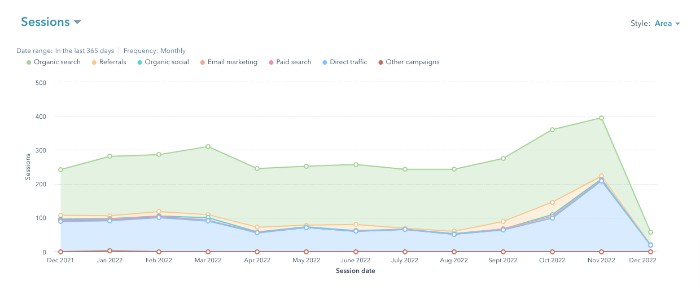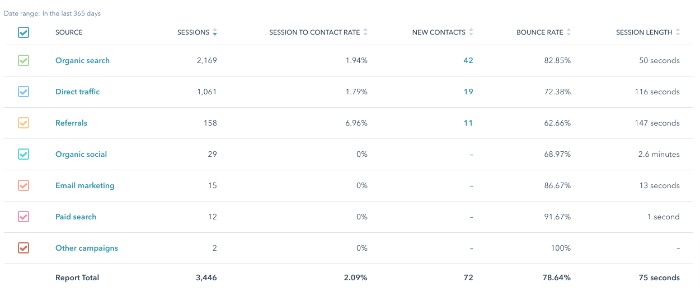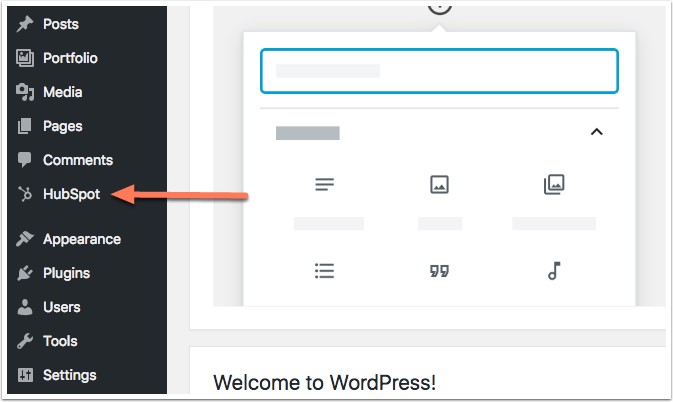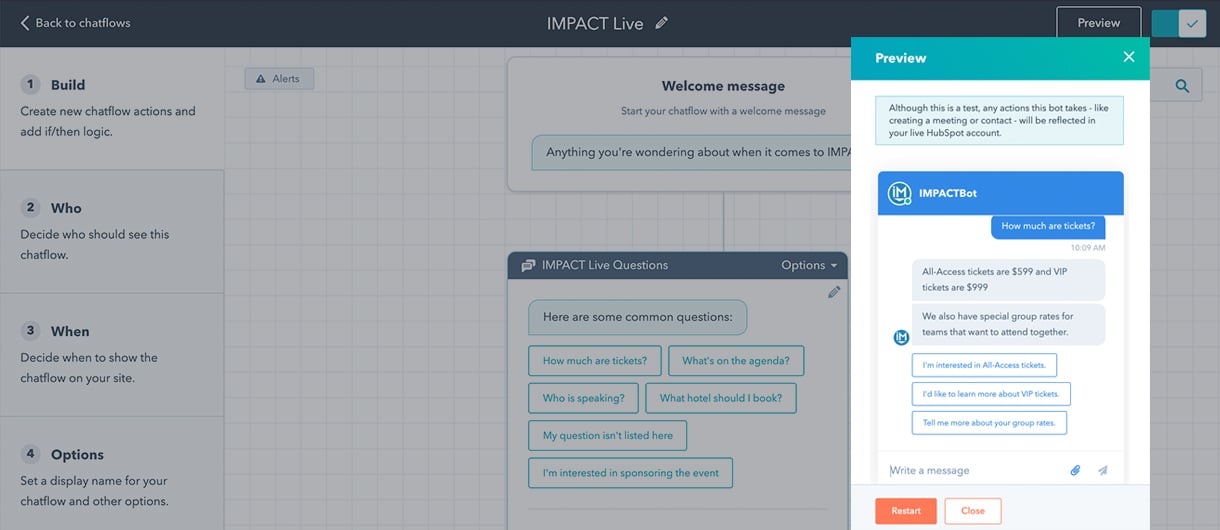HubSpot Website Analytics Best Practices
If you're not tracking your website's analytics, you're missing out on valuable data that could help improve your business. Marketers, sales managers, business owners, and sales reps can all benefit from understanding website analytics.
Fortunately, HubSpot makes it easy to track your website's performance. In this blog post, we'll share some of our best practices for using HubSpot's website analytic features. By following these tips, you'll be able to glean valuable insights about your website visitors and use that information to improve your sales strategy.

Why website analytics is important
When establishing an online presence, it is important to keep track of the results; this is where website analytics tools come in. By using hubspot website analytics, you will be able to gain valuable insights into how people engage with your site. For instance, you can view key metrics such as page views, bounce rate, impression, location, session duration, etc allowing you to evaluate the effectiveness of your web pages. You can also see where visitors are coming from and which content pieces generate the most engagement.
Does HubSpot have analytics?
Yes, HubSpot offers website analytics features as part of its suite of tools. You can use these tools to track website engagement and performance, including page views, session duration, and traffic sources. In addition, you can use HubSpot's website analytics tools to measure the effectiveness of your web pages and determine which content generates the most engagement.
Furthermore, HubSpot website analytics enables you to monitor the performance of individual traffic sources - vital information if you're looking to increase website traffic from search engines or through advertising campaigns.
With HubSpot, you get extensive tracking capabilities, giving you a thorough understanding of your website activity and making sure that all your efforts pay off in the long run. All these advantages make HubSpot an invaluable tool for any online business wanting to understand customers' behaviour patterns and drive better results.

Is HubSpot better than Google Analytics?
There is no definitive answer to this question. HubSpot and Google Analytics are both powerful tools for tracking website data. However, they offer different features and benefits.
- HubSpot website analytics provides extensive tracking capabilities, allowing you to understand your website activity in detail. You can track page views, session duration, and traffic sources, as well as measure the effectiveness of your web pages and determine which content generates the most engagement. In addition, the analytics tool enables you to monitor the performance of individuals’ contacts like prospects and customers - vital information if you're looking to increase website traffic from search engines or through advertising campaigns. Plus you can use more events to trigger a HubSpot workflow.
- Google Analytics offers a wide range of features, including tracking pageviews, unique visitors, and conversion rates. It also provides insights into user behaviour, such as how users navigate your website and which pages they visit most often. However, Google Analytics does not offer the same level of prospect and customer detail as HubSpot website analytics.
What HubSpot offer for website analytics
When it comes to monitoring the performance of a website, hubspot offers an array of analytic tools. You can use HubSpot's dashboards and reports to see exactly how visitors are engaging with your pages.
The tools HubSpot offers allow you to measure key performance metrics, such as page views and bounce rates. In addition, HubSpot's traffic report provides website owners with valuable insights into their site's performance over time. Here, you'll be able to view metrics such as total visits, unique sessions, and average session duration across user demographics, devices and geographic regions.
This data will equip website owners with the information they need to improve the browsing experience of their visitors. Finally, HubSpot's technology for analytics goes beyond simple reporting capabilities; it also provides predictive intelligence so that users can get ahead of potential challenges to ensure their website remains successful in the future.
Knowing what HubSpot offers for traffic analytics is essential for all webmasters looking to take their websites to the next level.
How to set up HubSpot website analytics
Setting up website analytics tool with HubSpot can help businesses increase the effectiveness of their online campaigns and attract more qualified leads. To begin, install the HubSpot tracking code on the pages you wish to track. This is done by adding a small snippet of JavaScript provided by HubSpot.

The installation process varies depending on the CMS you are using; for example, if you are using WordPress, simply copy and paste the code into your Theme Settings panel.
Once installed, it’s important to check that the code is working properly; otherwise, any data collected may be inaccurate or incomplete. To verify that it’s functioning properly, open your site in a web browser and use a tool like Google Tag Manager’s “Preview Mode” to ensure the code is loading correctly on each page.
After this initial setup, website analytics should be running in HubSpot and ready to provide valuable insights about user behaviour and preferences. With these data points, businesses can then make decisions that will boost their online performance and attract more customers.
Install HubSpot Tracking Using WordPress Plugin
If you are using WordPress, setting up HubSpot tracking is easy with a plugin like the official HubSpot Tracking Code Installation plugin. This plugin simplifies the process of installing and verifying your code in WordPress.
- Log in to your WordPress website admin dashboard.
- In the left sidebar menu, navigate to Plugins > Add New.
- Search for the HubSpot All-In-One Marketing – Forms, Popups, Live Chat plugin.
- In the upper right, click Install Now.
- Click Activate Plugin.
- In the left sidebar menu, navigate to HubSpot

- Click Log in to your account to finish the installation process. If you haven't set up a HubSpot account yet, you'll be prompted to create one.
For more details check the HubSpot article here Install and use the HubSpot WordPress plugin
Best practices for using HubSpot website analytics
In the ever-changing world of digital marketing, HubSpot website analytics is an invaluable tool for helping businesses stay ahead of the competition. HubSpot provides real-time traffic insights into how visitors engage with your website and helps you track website performance daily.
To make the most of HubSpot’s analytics capabilities, it’s important to understand best practices ranging from the process of setting up the HubSpot dashboard to segmenting web traffic and analysing data trends. To start, HubSpot recommends that you carefully evaluate your pages, blog posts and create distinct goals for each before setting up HubSpot tracking. Factors like segmenting web traffic by geography or device type can also help personalise experiences and gain valuable insight into user behaviour.
Additionally, creating regular reports tailored to measure specific aspects of metrics such as conversions or average engagement time will go a long way in helping you optimise your content and inform key decisions down the line. With HubSpot website analytics at your fingertips, there’s no limit to what you can learn about customer behaviour and make improvements accordingly.
To get the most out of HubSpot's powerful features, set realistic expectations and use them in combination with other growth strategies to achieve greater success!
Tips for getting the most out of HubSpot website analytics
Running a website involves more than just putting content out there in the world.
- Keeping track of visits, clicks and conversions is essential for understanding how your site is performing. For this reason, HubSpot website analytics can be invaluable. They provide a way to understand the performance of your pages and campaigns over time, allowing you to make modifications as needed.
- Setting goals, such as increasing page views or tracking clicks. This will allow you to measure metrics against your objectives and identify which tactics are working best for your website. You should also record trends over time, learning how seasonal changes, or other external events, affect your performance.
- Setup HubSpot Google analytics integration, the benefit of integrating your Google Analytics account into HubSpot is that your Google Analytics account will collect data on the visitors to your HubSpot site. This includes landing pages, blog pages, and website pages. (For more detail on Google Analytics integration with HubSpot)
- Set up notifications so you know when major events occur — like record high or low traffic — allowing you to respond quickly by creating relevant content or adjusting your approach.
- Finally, use the data HubSpot provides to build robust reports that give stakeholders a glimpse into how their investment is paying off. By taking these steps and leveraging HubSpot's web-based analytics platform judiciously, website owners can gain valuable insight into their visitors' behaviour and design more successful sites going forward.
How does website analytics fit into your marketing and sales process?
Website analytics can be used at different points in the marketing process. In the beginning, analytics help to identify target audiences and geographical markets, organic search, social media and direct traffic providing information on website visits, page views and visitor engagement times. This data can then be used to craft a tailored message that speaks directly to potential customers.
During campaigns, website analytics provide an understanding of how users are responding to content, helping marketers measure the success of campaigns and adjust their approach as needed. By tracking conversions and click-through rates, marketers can determine which strategies are working best for their target audience and make more informed decisions on where to focus resources.
Finally, website analytics enable marketers to create comprehensive reports that show the impact of campaigns and the effectiveness of different tactics. This data can be used to understand the impact of changes, inform decision-making, and evaluate progress towards marketing goals. By leveraging website analytics to track key performance indicators, marketers are better able to optimise their strategies for maximum success.
Campaign Example Steps
- Identify your campaign audience. Who are we talking to here? Understand your buyer persona before launching a campaign, so you can target them correctly.
- Set your goals + benchmarks. Having SMART goals can help you be sure that you’ll have tangible results to share with the world (or your boss) at the end of your campaign.
- Create your offer(s) + landing pages. Don’t forget to optimise your landing page for SEO, and have a clear value proposition and call to action (usually a form for the user to complete).
- Plan + build your automation + nurturing flows. Your campaign doesn’t end when leads convert to your landing page. Plan and build your follow-up campaigns to nurture leads down your funnel.
- Write a blog post. Your campaign is awesome – don’t hide it from the world. Use your blog posts as an opportunity to introduce readers to the valuable content they’ll find in your offer.
- Share it on social media. Promote your blog post and offer through social media to drive traffic to the top of your funnel.
- Add in long tail keywords. Make sure your campaign is SEO friendly – that way, interested prospects will find your campaign long after you stop actively promoting it.
- Consider paid search and other channels. Other channels can be a part of your inbound campaign, too – just be sure that you are measuring the effectiveness of these channels.
- Track your URLs. Where is your traffic coming from, and how are visitors finding you? Tracking URLs can help.
- Report on your results. Hard work shouldn’t go unmeasured. You set goals at the very beginning; now it’s time to celebrate your success. Organise and show off your numbers at the end of the campaign using website analytics.
- Repeat the above for your next campaign based on your campaign calendar and the resources available.
Remember that there are generally two types of campaigns: evergreen and promotions. An evergreen campaign is a marketing initiative without an expiration date, meaning it can be run repeatedly. On the other hand, time-sensitive campaigns like flash sales or seasonal promotions are short-term tactics that business owners use for more immediate results.
Conclusion
Website analytics is an important tool for understanding how your website is performing and identifying ways to improve traffic. Hubspot offers a comprehensive suite of website analytics tools that are easy to set up and use. By following the best practices we’ve outlined, you can get the most out of Hubspot website analytics and improve your website traffic.
If you need help getting started with HubSpot CRM or want to learn more about how to use Hubspot website analytics, call us today. We would be happy to walk you through the process and answer any questions you have.




